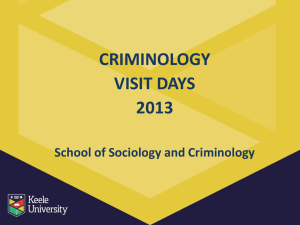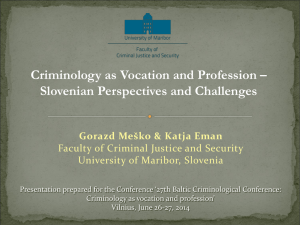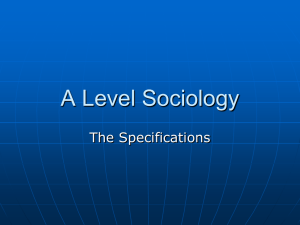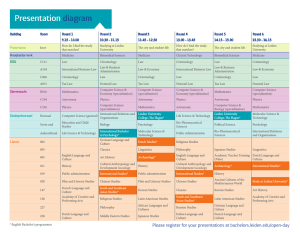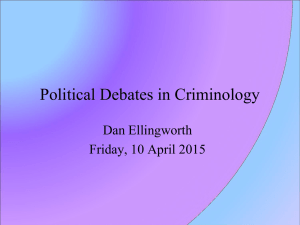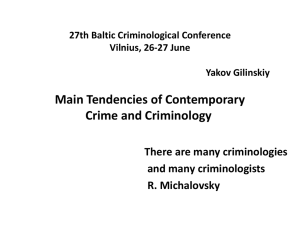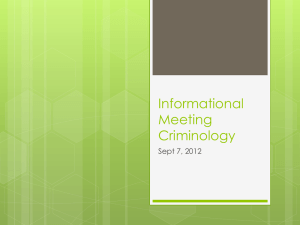Criminology Research Network - Sociologiska institutionen
advertisement
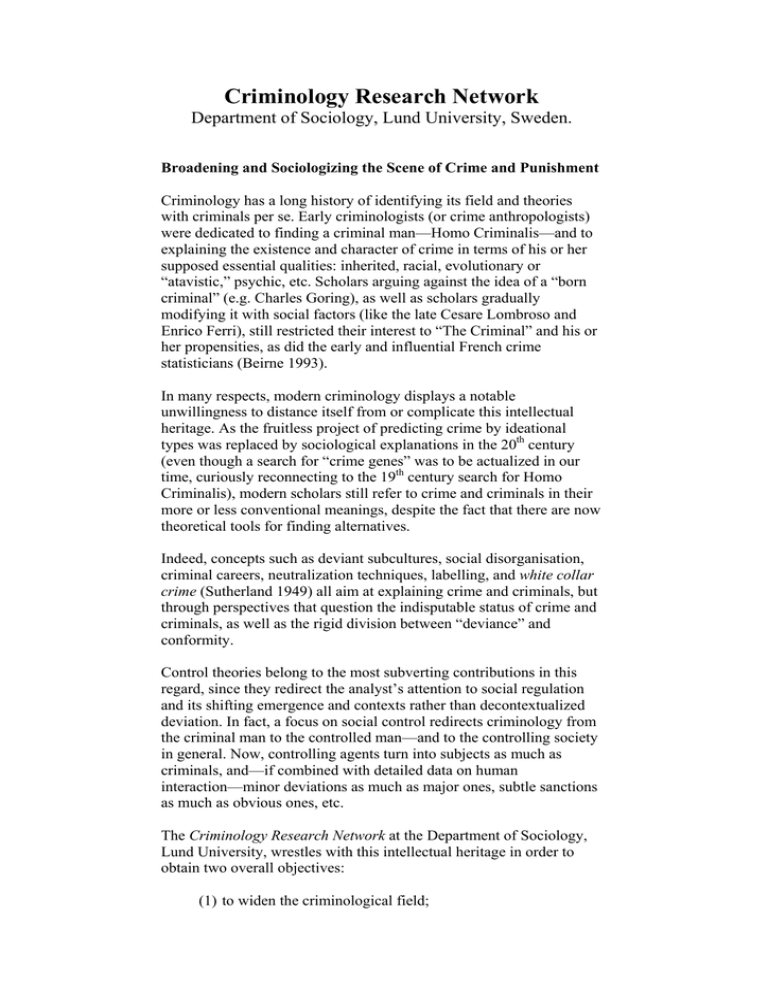
Criminology Research Network Department of Sociology, Lund University, Sweden. Broadening and Sociologizing the Scene of Crime and Punishment Criminology has a long history of identifying its field and theories with criminals per se. Early criminologists (or crime anthropologists) were dedicated to finding a criminal man—Homo Criminalis—and to explaining the existence and character of crime in terms of his or her supposed essential qualities: inherited, racial, evolutionary or “atavistic,” psychic, etc. Scholars arguing against the idea of a “born criminal” (e.g. Charles Goring), as well as scholars gradually modifying it with social factors (like the late Cesare Lombroso and Enrico Ferri), still restricted their interest to “The Criminal” and his or her propensities, as did the early and influential French crime statisticians (Beirne 1993). In many respects, modern criminology displays a notable unwillingness to distance itself from or complicate this intellectual heritage. As the fruitless project of predicting crime by ideational types was replaced by sociological explanations in the 20th century (even though a search for “crime genes” was to be actualized in our time, curiously reconnecting to the 19th century search for Homo Criminalis), modern scholars still refer to crime and criminals in their more or less conventional meanings, despite the fact that there are now theoretical tools for finding alternatives. Indeed, concepts such as deviant subcultures, social disorganisation, criminal careers, neutralization techniques, labelling, and white collar crime (Sutherland 1949) all aim at explaining crime and criminals, but through perspectives that question the indisputable status of crime and criminals, as well as the rigid division between “deviance” and conformity. Control theories belong to the most subverting contributions in this regard, since they redirect the analyst’s attention to social regulation and its shifting emergence and contexts rather than decontextualized deviation. In fact, a focus on social control redirects criminology from the criminal man to the controlled man—and to the controlling society in general. Now, controlling agents turn into subjects as much as criminals, and—if combined with detailed data on human interaction—minor deviations as much as major ones, subtle sanctions as much as obvious ones, etc. The Criminology Research Network at the Department of Sociology, Lund University, wrestles with this intellectual heritage in order to obtain two overall objectives: (1) to widen the criminological field; (2) to advance the goal of sociologizing criminology. The Network questions research relying on essentializing pictures of crime and criminals; it does not find a single-minded focus on conventional crimes or officially recognized social problems and their proclaimed solutions sufficient. Instead, it aims to broaden criminology’s narrow devotion to obvious norm violations and their societal responses (but certainly not excluding them), as there is not enough space for scientific creativity solely within the enduring heritage left by early criminologists. Our efforts aim at expanding the field so that (a) phenomena typically not associated with criminology, but empirically and theoretically embedded into it, are carefully researched; (b) criminology’s sociological wing is academically strengthened; and (c) sociology itself is developed by using “the social”—in its broadest and yet most radical sense—when inquiring into the scene of crime and punishment, deviance and control. The fact that the Network’s inquiry includes a search for subtle phenomena in itself constitutes a mechanism to widen the field. There is a lot to learn from studies of less conspicuous social deviations and control dramas, for instance around individuals with disabilities and their social worlds (Jacobsson 1999; 2000), or around ethnic minorities (Basic 2009). A sociologically-grounded criminological perspective can be directed to many areas not necessarily thought of as “criminological.” There is also a lot to learn from re-reading classics— Georg Simmel, Émile Durkheim, Marcel Mauss—since they typically are liberated from current debates and worries, and therefore may provide a fresh gaze. Contemporary and Classic Tools—and Classics turned Contemporary Since its establishment in 1993, the Network has used a broad variety of interrelated analytic and methodological tools within sociology to academically operationalize its objectives, often combined within one and the same project. The following description is far from complete but provides an image of how we work. The linguistic turn has been used to discern and explain mechanisms of social control in their most detailed and subtle manifestations, notably in areas typically not at all associated with crime and punishment (e.g. the world of the deaf and hard of hearing, see Jacobsson 1999; 2000). Analytic sensitivity to the spoken word, oral narratives, and their embedded societal discourses has similarly helped to uncover social processes in institutional and cultural forms: in victim support organizations (Ryding 2005), in policemen’s accounts of women battering cases (Lundberg 2001), and in patterns of accounts relating to bribery (Thelander 2006), as well as in the various social meanings of corruption (Wästerfors 2004) and male victimization (Burcar 2005; Burcar & Åkerström 2009). Spoken words are, in general, carefully regulated, and when we analyze them the criminological field is widened, since these regulations generate their own “crimes” and “punishments”—and villains, fools, and heroes (see Jacobsson & Åkerström 1997). In practice, discourse also constitutes those various fields that criminologists should be interested in—police work, prosecutors’ work, crime prevention, victim support, bribery, etc.—further underlining its interest for us. Constructionism—closely linked to the linguistic turn—has helped us to show both how conventionally defined crimes are sustained or rhetorically challenged (e.g. bribes in Thelander 2006, Wästerfors 2004, and Jacobsson 2006, and violence in Åkerström 1998; 2003), and also how the socially cherished “ideal victim” (Christie 2001) is put into an intricate play of construction and deconstruction in contemporary society (Åkerström & Sahlin 2001; Ryding 2005). Constructionism is also used to research ethnicity in institutional youth care (Basic 2009), to study elderly abuse and care scandals (Jönson, 2006), to analyze performed masculinity in victim narratives (Åkerström, Burcar, & Wästerfors 2011), to uncover transformations of sorrow to anger and “victim” to “survivor” in victim support work (Ryding 2009), and to study the definition of violence from the security industry’s perspective (Mallén forthcoming). In these studies, constructionism relativizes rigid demarcations around “crime, “criminal,, “victim,” “inmate,” “staff,” “man,” and “woman,” etc., and invites “the social” into the analysis: people’s active handling of these concepts, with wider discourses and contexts as their resources. Contemporary sociology is thereby cultivated and elaborated within criminology, and criminology is expanded. Cultural and interactional analyses are developed both in relation to the society in general and to particular social issues—victim support, corruption scandals, violence, drugs, non-taxed work, etc.—but also in relation to particular groups or subcultures. Students in our criminology courses SOCA71 and SOCA81 often engage in investigating the social worlds of marginal actors like graffiti artists, young criminals, drug users, female offenders, etc., thereby trying to uncover cultural denominators in attitudes, practices, ideals, and identities. Life style analyses of criminals are closely attached to these efforts (Åkerström 1993). Such analyses reconnect to classic (and prepositivistic) notions in early criminology, where the individual and his or her will and agency were attended to, although in our case updated with contemporary sociology and social psychology as, for instance, in Erving Goffman’s versions. Thus, “the social” is incorporated into the research so that an individual criminal’s or “deviant” actor’s life and mind (Homo Criminalis) are understood as deeply formed by, interconnected with, and ultimately dependent on others. Similarly, our interest in crime victims is informed by an interest in interactions formed by society’s current picture of them as first and foremost worthy of sympathy. Svensson (2006) revealed interactional intricacies and dilemmas concerning support staff. Document studies, interview studies, and ethnography provide us with rich data from a variety of sites with criminological relevance: unauthorized migrants in Sweden (Frank 2009; 2010), conflict managing practices and staff priorities in Swedish institutional youth care (Wästerfors 2009; Basic, Thelander, & Åkerström 2009), elderly residences (Jönson 2006b), Swedish prosecutors’ definition of “objectivity” (Jacobsson 2008), media users’ attitudes and actions towards reports on crimes and scandals (Åkerström 2008), drug-users’ biographies and everyday practices (Andersson 1991), etc. When it comes to ethnography, researchers within the network have, for instance, “gone along” with policemen in their daily work (Lundberg 2001), with victim supporters in their voluntary activities (Ryding 2005), with staff and patients at an emergency clinic (Åkerström 1996), and with youth and staff in care settings (Wästerfors 2009), and have conducted in-depth interviews with thieves and addicts (Åkerström 1993), businessmen (Wästerfors 2008), aid workers (Thelander 2006), and social workers and probation officers (Svensson, 2009). In cooperation with professor Abby Peterson at Göteborg University, today’s multifaceted and often nongovernmental policing of ethnicity is investigated with the help of diverse empirical sources and methods. (Peterson and Åkerström, 2013) There is, in other words, no hesitation within this network toward getting in touch with whoever or whatever it takes in order to gather interesting data through direct interaction. This methodological approach stems from the network’s ambition to sociologize criminology, since it is drawing and elaborating on the strong field research tradition within this discipline and within the Department of Sociology at Lund University. We are not satisfied with general descriptions, nor with clichéed examples or predictable personas from, for instance, tabloid newspapers, but strive to complicate the fields and actors at issue by incorporating instances from a plethora of social life, as it takes form when a researcher gets into (and interactionally defines) a field. Our recurrent field works have also led to methodological contributions (for instance Åkerström, Jacobsson, & Wästerfors 2004; 2013 forth). Finally, classic social scientists and thinkers, such as Émile Durkheim, Georg Simmel, George Herbert Mead, Erving Goffman, Mary Douglas, Max Scheler, Mikhail Bakhtin, Kenneth Burke, and Marcel Mauss, are continually being used and reused. Without Bakhtin’s concept of dialogism, for instance, studies of discursive social control turn meagre (Jacobsson 2000), without Burke’s analyses of rhetoric, “courtships” as an alternative to bribes might not have been discovered (Wästerfors 2004), and without Mauss, our studies of bribery and corruption would lack the enriching and culturally deepening background of his anthropology of the gift (Åkerström 2011; 2013 and Wästerfors 2004). It is not merely in new data that the network finds its impetus to advance analysis, but as data is theorized by (and as analyses and projects are informed by) classic social thought. This also corresponds with theoretical traditions at the Department of Sociology at Lund University. The strategy to reread classics goes hand in hand with our objective to advance toward the goal of sociologizing criminology. It is certainly not distracting, we argue, to read and draw on authors that typically fall outside criminology, but rather it is augmenting and enriching, since a step “back” to classics in social science often means a step forward for contemporary research. Activities The Criminology Research Network at the Department of Sociology engages in … • • • • • • • Research projects and research applications Theory and method development Publishing and editing Teaching and course development Scientific conferences, seminars, and meetings Evaluations Media and other societal contacts References Andersson, Berit (1991) Att förstå drogmissbruk. Praktiken, situationen, processen. Lund: Arkiv. Basic, Goran (2009) Etnicitet i ungdomsvården. Yrkesverksammas och ungdomars framställningar. Stockholm: Statens institutionsstyrelse. Basic, Goran; Thelander, Joakim & Åkerström, Malin (2009) Vårdkedja för ungdomar eller professionella? En processutvärdering av projektet "Motverka våld och gäng". Stockholm: Statens institutionsstyrelse. Beirne, Piers (1993) Inventing Criminology. Essays on the Rise of ‘Homo Criminalis’. Albany: State University of New York Press. Burcar, Veronika (2005) Gestaltningar av offererfarenheter. Samtal med unga män som utsatts för brott. Lund: Sociologiska institutionen, Lunds universitet. Burcar, Veronika & Åkerström, Malin (2009) “Negotiating a Victim Identity: Young Men as Victims of Violence”. Journal of Scandinavian Studies in Criminology and Crime Prevention 10: 37-54. Frank, Denis (2009) ”De oauktoriserade migranterna i svensk byggnadssektor – en studie i svensk deportationspolitik 1990-2004”. Sociologisk Forskning 2. Frank, Denis (2010) ”Från statligt formad invandring till företagsdriven invandring – en jämförande studie av 2008 års regler för arbetskraftsinvandring till Sverige”, forthcoming. Jacobsson, Katarina (2006) ”A Token of Gratitude”? A Morally Ambiguous Case of Bribery. Journal of Scandinavian Studies in Criminology and Crime Prevention, 7:3-22, 2006. Jacobsson, Katarina (1999) ”Conveying the ‘Right’ Knowledge: Rhetorical Work with Families of the Deaf” in Perspectives on Social Problems, Vol. 11, edited by J. Holstein and G. Miller. Greenwich, CT: JAI Press. Jacobsson, Katarina (2000) Retoriska strider. Konkurrerande sanningar i dövvärlden. Lund: Palmkron. Jacobsson, Katarina (2008) ”’We Can’t Just Do It Any Which Way’ Objectivity Work among Swedish Prosecutors. Qualitative Sociology Review IV: 1: 46-67. Jönson, Håkan. (2006) Vårdskandaler i perspektiv : debatter om vanvård, övergrepp och andra missförhållanden inom äldreomsorg. Malmö. Egalité. Jönsson, Håkan. (2006 b) Is it Racism? Scepticism and Resistance towards Ethnic Minority Care Workers among Older Care Recipients. Journal of Gerontological Social Work.49: 79 – 96. Lundberg, Magnus (2001) Vilja med förhinder. Polisers samtal om kvinnomisshandel. Stehag: Brutus Östlings bokförlag Symposion. Mallén, Agneta (2011 forthc.) ”Vad är våld? Väktares berättelser om våld och hot om våld på arbetsplatsen”. Nordisk Tidskrift for Kriminalvidenskap. Peterson, Abby och Åkerström, Malin (red) 2013. Den sorterande ordningsmakten studier av etnicitet och social kontroll. Malmö: Bokbox Ryding, Anna (2009) ”Transforming the sorrow to anger, the victim to survivor. A case study of organized victim support work in Sweden. Sundaram, M. S.; Jaishankar, P. K. & Ramdoss, S. (eds.) Crime Victims and Justice: An introduction to Restorative Principles. New Delhi: Serial Publications. Ryding, Anna (2005) Välviljans variationer. Moraliska gränsdragningar inom brottsofferjourer. Lund: Sociologiska institutionen, Lunds universitet. Sutherland, Edwin (1949) White Collar Crime. New York: Holt, Rinehart and Winston. Svensson, Kerstin. (2006) Socialt arbete med brottsoffer: sympati, empati och organisering. Stockholm. Carlssons. Svensson, Kerstin. (2009) ”Identity Work through Support and Control” Ethics and Social Welfare. 3:234-248. Thelander, Joakim (2006) Mutor i det godas tjänst?Biståndsarbetare i samtal om vardaglig korruption. Lund: Sociologiska institutionen, Lunds universitet. Wästerfors, David (2004) Berättelser om mutor. Det korruptas betydelse bland svenska affärsmän i Öst- och Centraleuropa. Stehag: Brutus Östlings bokförlag Symposion. Wästerfors, David (2008) “Businessmen as folk ethnographers”. Ethnography 2008 9(2): 235–256. Wästerfors, David (2009) Konflikthantering i ungdomsvård ur ett sociologiskt perspektiv. Stockholm: Statens institutionsstyrelse. Åkerström, Malin (1993) Crooks and Squares. Lifestyles of Thieves and Addicts in Comparison to Conventional People. New Brunswick: Transaction. Åkerström, Malin (ed.) (2008) Medier, brott och den aktiva publiken. Om brottsrapportering och kreativ medieanvändning. Malmö: Bokbox. Åkerström, Malin (2011) Känsliga gåvor - Mutblickens sociala förvecklingar Malmö: Liber Åkerström, Malin (2013). Suspicious Gifts - Bribery, Morality and Professional Gifts. New Brunswick: Transaction Åkerström, Malin (1996) “Waiting: A Source of Hostile Interaction in an Emergency Clinic”. Qualitative Health Research 7:4:504-520. Åkerström, Malin (1998) “The Moral Crusade on Violence In Sweden - Moral Panic, or Material For Small-Talk Indignation”. Ruggerio, V.; South, N. & Taylor, I. European Criminology: a Handbook. London: Routledge. Åkerström, Malin (2003) “Slaps, Punches, Pinches – But not Violence. Boundary Work in Nursing Homes for the Elderly”. Symbolic Interaction 25: 4: 515-536. Åkerström, Malin; Burcar, Veronika; Wästerfors, David (2011 forthc.) ”Balancing Contradictory Identities. Performing Masculinity in Victim Narratives”. Sociological Perspectives. Åkerström, Malin; Jacobsson, Katarina & Wästerfors, David (2004) ”Reanalysis of Previously Collected Material.” Seale, Clive; Silverman, David & Gubrium, Jaber F. & Gobo, Giampetro (eds.) Qualitative Research Practice. London: Sage. Åkerström, Malin & Sahlin, Ingrid (eds.) (2001) Det motspänstiga offret. Lund: Studentlitteratur.

